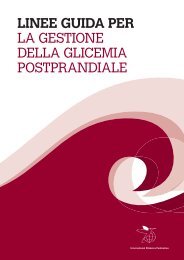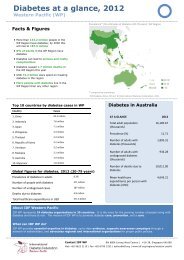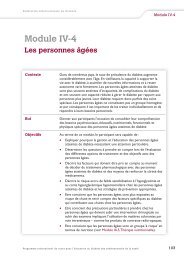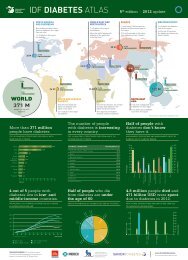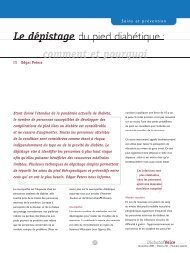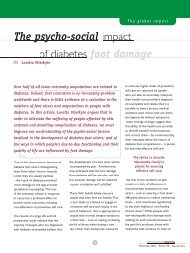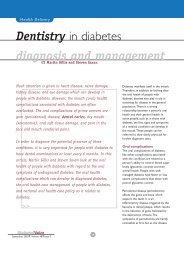Evidence-base - International Diabetes Federation
Evidence-base - International Diabetes Federation
Evidence-base - International Diabetes Federation
Create successful ePaper yourself
Turn your PDF publications into a flip-book with our unique Google optimized e-Paper software.
The Australian guidelines recommend using the Framingham risk equation unless<br />
the person with diabetes is in a high risk category which include previous CVD event;<br />
age > 60 years; microalbuminuria; moderate or severe chronic kidney disease (CKD)<br />
(persistent proteinuria or eGFR < 45); extreme level of a single risk factor [6] .<br />
The New Zealand guideline recommends annual risk assessment in people<br />
with diabetes from the time of diagnosis and calculation of CVD risk using<br />
the New Zealand Cardiovascular Risk Charts. People with diabetes with<br />
microalbuminuria, diabetes duration of 10 or more years or with HbA 1c<br />
consistently ≥ 8% / 64 mmol/mol are moved up one risk category [7] .<br />
The Canadian guidelines consider the following with diabetes at high CVD risk:<br />
men aged ≥ 45 years, women aged ≥ 50 years; men < 45 years and women < 50<br />
years with ≥ 1 of the following: macrovascular disease; microvascular disease;<br />
multiple additional risk factors; extreme level of a single risk factor; duration<br />
of diabetes > 15 years with age > 30 years [8] . A risk calculator is not used to<br />
assess CVD risk.<br />
The Scottish SIGN guideline considers all people with diabetes over the age of<br />
40 years to be at high risk and do not require a risk assessment with a scoring<br />
system [9] .<br />
WHO recommends decisions about whether to initiate specific CVD preventive<br />
action, and with what degree of intensity, should be guided by estimation of the<br />
risk of vascular events using risk prediction charts. Individuals who do not need<br />
risk stratification because they are already at high CVD risk include those who<br />
have already experienced a CVD event or have very high levels of individual risk<br />
factors which includes people with 2 diabetes with overt nephropathy or other<br />
significant renal disease [10] .<br />
Ultimately the choice of risk assessment strategy must be made at a country<br />
level taking into account country-specific CVD and risk factor epidemiological<br />
data, availability and cost of CVD preventive treatments, and resource<br />
implications of the size of the population identified at high risk and requiring<br />
intervention.<br />
There is an evidence-<strong>base</strong> for integrated multiple risk factor intensive<br />
intervention, particularly in high-risk people with type 2 diabetes with<br />
microalbuminuria, showing powerful absolute and relative risk reductions in<br />
the Steno-2 study [11] and in its subsequent 5.5 years follow-up which showed a<br />
further benefit in the reduction of mortality rates [12] .<br />
People with diabetes identified at increased CVD risk require interventions<br />
to reduce risk. High risk individuals should be encouraged to modify lifestyle<br />
(see Chapter 5: Lifestyle management), smokers should cease smoking,<br />
the overweight should reduce weight and blood glucose control should be<br />
optimised. These individuals should also be treated with blood pressure<br />
lowering medications (see Chapter 10: Blood pressure control) and statins,<br />
unless contraindicated, not tolerated or clinically inappropriate. The wide<br />
availability of low cost generic statins is likely to make them cost effective in<br />
most parts of the world.<br />
There is strong and consistent evidence that statins reduce the risk of death<br />
or CVD events irrespective of age and gender, and across a wide range of<br />
cholesterol levels [13-18] .<br />
11 CARDIOVASCULAR RISK PROTECTION<br />
75





